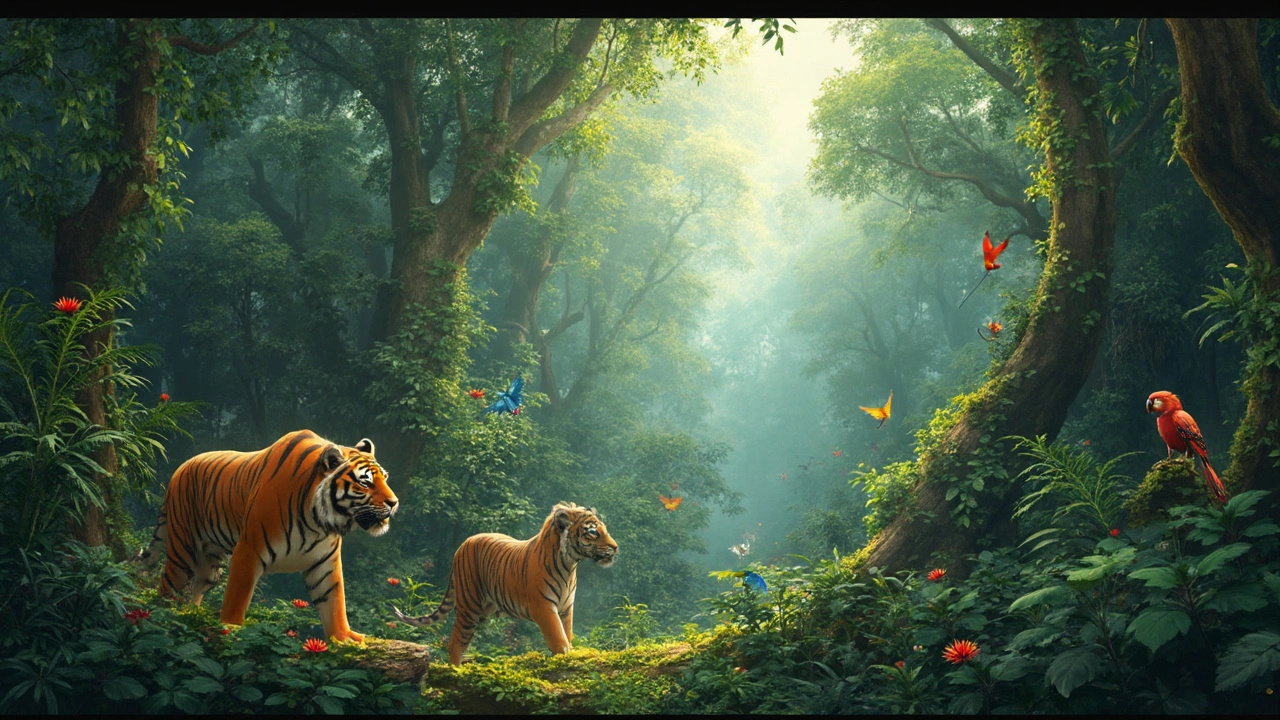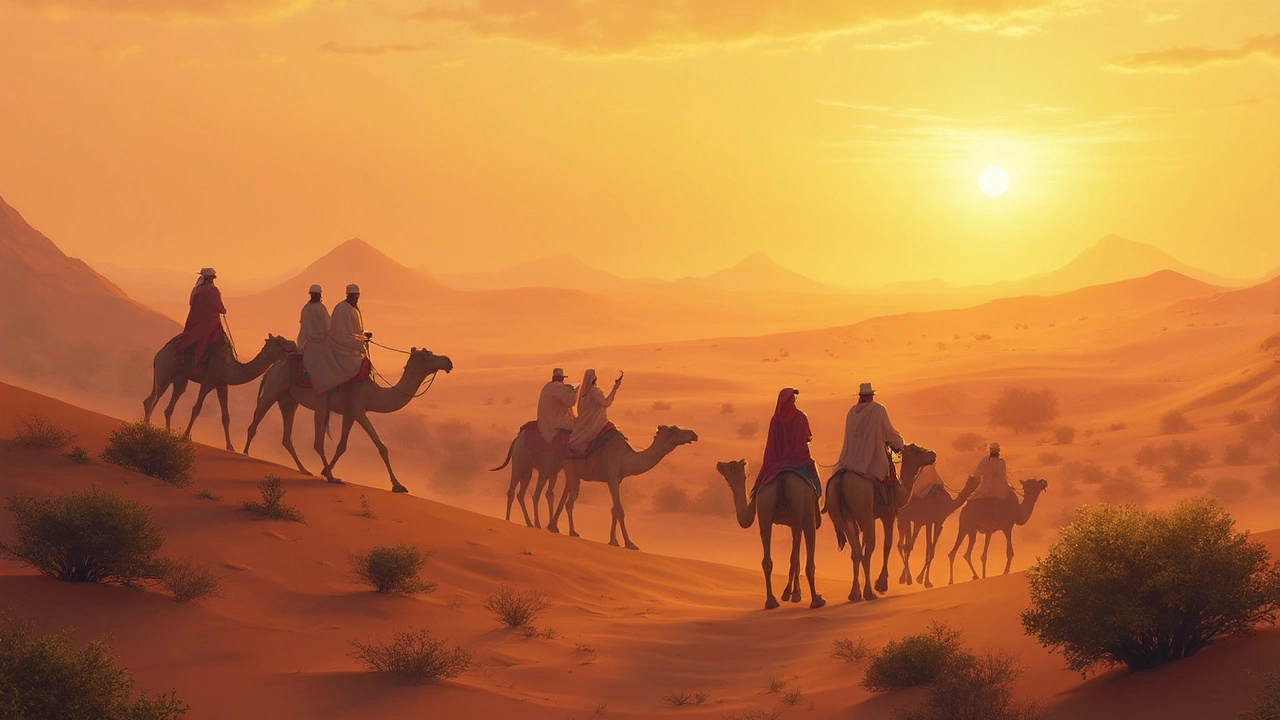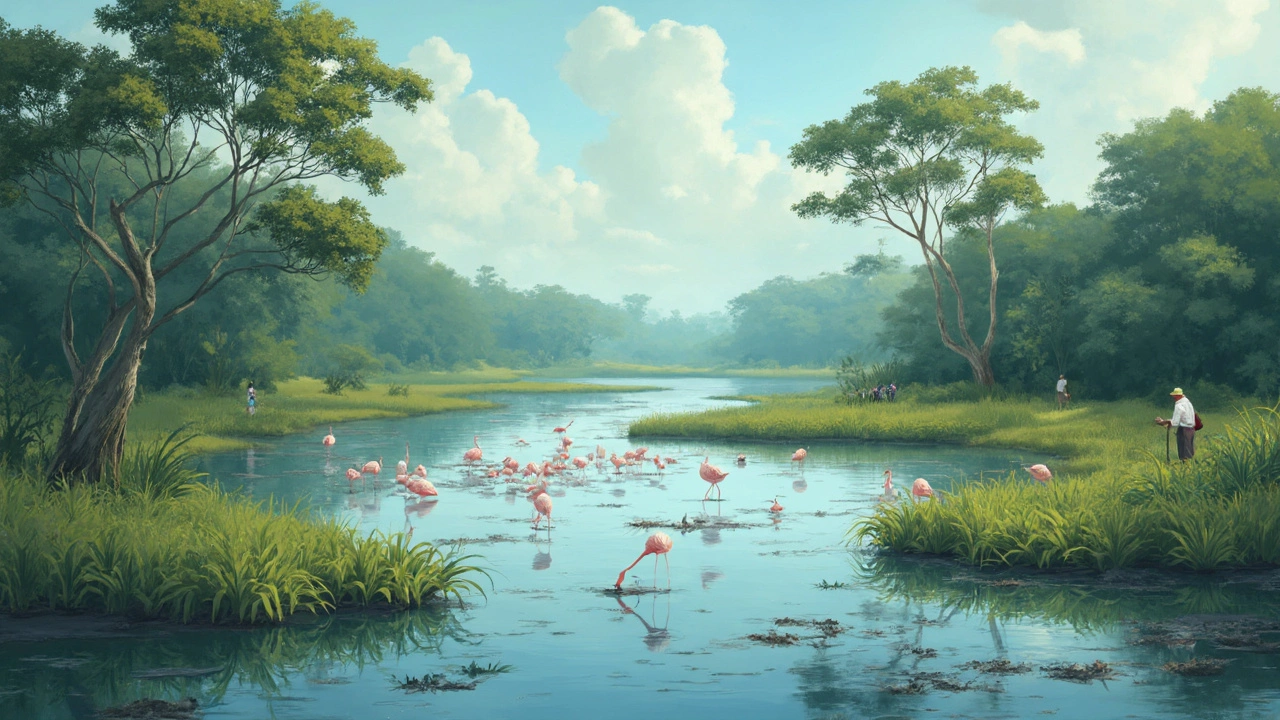
- Created by: Lydia Carmichael
- Completed on: 31 Mar 2025
- Categories: Environment
Have you ever wondered about the vast communities of life that thrive in different corners of our planet? Ecosystems are nature's way of organizing life, each with its distinct characteristics and inhabitants. They range from the dense canopies of tropical forests to the endless waves of the ocean. But what exactly defines these ecosystems, and why should we care?
Let's start with forests. Ever thought about how crucial these green giants are? Beyond being home to countless species, forests absorb carbon dioxide, helping combat climate change. They're like Earth's lungs, breathing life into our world. On the flip side, you've got deserts. They might seem barren, but they're packed with life adapted to survive with minimal water. From cacti to camels, desert life is a masterclass in resilience.
And let's not forget about grasslands, the unsung heroes that cover about a quarter of the Earth's land and feed a significant portion of the world's population. Whether it's the vast savannas of Africa or the prairies of North America, grasslands support a wealth of biodiversity and are essential for agriculture.
- Forests: The Lungs of Earth
- Deserts: Nature's Tough Survivors
- Grasslands: The Plains of Plenty
- Aquatic Freshwaters: Rivers and Lakes
- Marine Ecosystems: Life Below Water
- Tundra: The Cold Frontier
- Wetlands: Nature's Sponges
Forests: The Lungs of Earth
Forests are truly the unsung heroes of our planet, playing a critical role in maintaining the Earth’s health. Often called the lungs of the Earth, **forests** are vital in absorbing carbon dioxide and releasing oxygen. This process is crucial for keeping the air clean and tackling climate change.
Diving deeper, you'll find stunning diversity within **forest ecosystems** themselves. There are three main types: tropical, temperate, and boreal. Each is unique and supports a variety of wildlife, from the vibrant toucans of the Amazon to the majestic moose of the northern boreal forests. Each type provides essential jobs like climate regulation, water cycle maintenance, and habitat for countless species.
A fascinating fact is that tropical forests alone house about 80% of the world’s terrestrial biodiversity. Imagine that! In addition, these **ecosystems** are running what you could call a natural pharmacy, offering resources for many modern medicines.
But here’s a stark reality check. According to some data from recent years, we lose about 10 million hectares of forest annually due to deforestation. That's an area roughly the size of Iceland disappearing every year. Scary, isn't it? Yet, by simply supporting sustainable forestry practices or opting for products with certifications like the Forest Stewardship Council (FSC), we can make a difference.
Here's a quick, helpful reminder:
- Reduce paper use in everyday activities. Digital options are eco-friendlier.
- Choose wood products that are sustainably sourced.
- Support organizations dedicated to reforestation and conservation.
Taking small steps can collectively lead to a massive impact, helping our beloved forests continue to thrive for generations to come.
Deserts: Nature's Tough Survivors
When you think about deserts, what comes to mind? Endless sand, scorching sun, and not much else? Well, deserts are way more fascinating than they first appear. These ecosystems cover about one-third of Earth's land surface and are home to a surprisingly diverse range of species that have adapted to the harshest conditions nature throws at them.
Take the Sahara Desert, for instance. It's the world's largest hot desert, yet it's not all about dunes. You'll find mountains, plains, and even oases dotted throughout. And then there's the Gobi Desert in Asia, where temperatures swing from scorching summers to freezing winters. Talk about an extreme climate!
Now, how do plants and animals make it in such an unforgiving environment? Let's start with plants. Cacti and succulents are desert icons, storing water in their thick stems. This isn't just a nifty trick — it's essential for survival. And then there are animals like camels, known as the ships of the desert. These incredible creatures can travel long distances without water, thanks to their ability to store fat in their humps.
Another fascinating desert survivor is the kangaroo rat. Though tiny, this rodent hardly ever drinks water, getting all it needs from the seeds it munches on. And let’s not forget the fennec fox. With its huge ears, it's not only cute but also super adaptable to the desert's heat.
Despite their arid conditions, deserts are also fragile ecosystems, sensitive to changes like climate shifts and human activities. Protecting these unique landscapes is key to maintaining biodiversity and balancing our planet's ecosystems.
So, next time you think of deserts, remember that they're more than just dry land. They're vibrant, resilient environments teaming with life that's exceptionally well-equipped to handle whatever comes its way.
Grasslands: The Plains of Plenty
When you think of grasslands, you might picture endless horizons dotted with herds of grazing animals, and you'd be spot on. These ecosystems cover about a quarter of the Earth's land area and are found on every continent except Antarctica. They're the world's breadbasket, supporting agriculture with nutrient-rich soil perfect for growing crops like wheat and corn.
But grasslands aren't just about farming. They are home to an array of wildlife, from the iconic bison of North America to African elephants in the savannas. These animals play crucial roles, like grazing, which helps maintain the health of these ecosystems by promoting new growth and spreading seeds. It’s a slick cycle of life that keeps everything in balance.
There are two main types of grasslands: tropical and temperate. Tropical grasslands, like the savannas of Africa, experience warm temperatures year-round with a distinct wet and dry season. Temperate grasslands, such as the prairies of the U.S. or the steppes in Mongolia, have hotter summers and colder winters, with rainfall being more evenly distributed throughout the year.
Grasslands also act as carbon sinks. They capture and store carbon dioxide from the atmosphere, playing a part in regulating climate. However, threats like overgrazing, agricultural expansion, and urbanization pose risks to these ecosystems. Protecting grasslands is vital not just for supporting biodiversity but also for maintaining ecological functions like water filtration and carbon storage.
So, next time you enjoy a bowl of cereal or a loaf of bread, remember the grasslands that make it all possible. They're pretty remarkable when you think about it!

Aquatic Freshwaters: Rivers and Lakes
When you think about the world's most dynamic ecosystems, rivers and lakes surely make the list. These aquatic environments might not cover as much area as oceans, but they're packed with life and significance. From providing drinking water to being a home for thousands of species, freshwater ecosystems play a vital role in our daily lives.
Freshwater rivers are often considered the lifeblood of continents. Flowing from mountains to oceans, they carry nutrients and sediments that nourish lands farmlands rely on. Many major cities are built on riverbanks because of this invaluable resource. Think of the Nile, the Amazon, or the Yangtze—each a powerhouse of culture, commerce, and biodiversity.
Lakes, on the other hand, are mostly still water bodies that offer a peaceful ecosystem for various species. A single lake can support hundreds of species of fish, birds, and plants. Notably, Lake Baikal in Russia is the world's deepest and oldest freshwater lake, home to over 3,500 animal species, two-thirds of which can't be found anywhere else.
"Freshwater ecosystems are indispensable for human survival, providing water, food, and ecological services that we can't live without." — The Freshwater Biological Society.
Despite their importance, freshwater systems face threats like pollution, overfishing, and climate change. It's alarming to know that just 2.5% of the world's water is freshwater, and less than 1% is easily accessible. This calls for better conservation efforts.
- Protect waterways from industrial pollution.
- Engage in local habitat restoration projects.
- Advocate for policies that protect freshwater ecosystems.
Involving yourself in these actions makes a big difference. Let's do the best we can to safeguard these essential ecosystems for future generations.
Marine Ecosystems: Life Below Water
Diving into the world of marine ecosystems, it's like opening a door to a whole new universe! These ecosystems are some of the most diverse and vital on our planet. Covering over 70% of the Earth's surface, oceans are a massive source of oxygen and play a key role in regulating our climate.
One of the most incredible features of marine systems is their biodiversity. Coral reefs, often dubbed the rainforests of the sea, are vibrant underwater gardens teeming with life. Did you know that a single reef can be home to thousands of species? It's mind-blowing!
But marine life isn't just about colorful fish and corals. The deep sea, with its mysterious creatures like the lanternfish, thrives under extreme conditions. These species have adapted to the pitch darkness and crushing pressures—nature's innovation at its finest.
And let's not forget the critical roles that marine ecosystems play. They provide food and jobs for millions of people worldwide, and ocean currents help distribute heat from the equator towards the poles. It's like Earth's natural climate control system. Here's a quick look at how crucial marine ecosystems are:
| Importance | Impact |
|---|---|
| Oxygen Production | Over 50% of breathable oxygen |
| Carbon Storage | Absorbs about a third of CO2 emissions |
| Food Source | Over a billion people rely on seafood as their primary protein source |
But hey, it's not all smooth sailing. Human activities like overfishing and pollution are putting these precious ecosystems in danger. That's why it's vital to raise awareness and take action to protect them. Simple steps like reducing plastic use and supporting sustainable fishing can make a big impact.
So next time you're by the beach, take a moment to appreciate the bustling life beneath the waves and remember the massive role oceans play in our day-to-day lives.
Tundra: The Cold Frontier
Think of the tundra as nature's ice box, a vast and chilly ecosystem where life hangs on, despite the freezing conditions. Found mostly in the Arctic and high mountain tops, tundras don't get much love affair from not-so-hardy animals or plants. But hey, those that call it home are adapted to some of the harshest climates on Earth.
The tundra is recognized for its extremely low temperatures and short growing seasons. We're talking summers that might just hit a high of 10°C (50°F) if you're lucky. And don’t expect to see any trees – the climate doesn't exactly roll out the welcome mat for them. Instead, you'll see lichens, mosses, and tiny flowers that are pros at soaking up the brief summer sun.
Ever heard of permafrost? It's the permanently frozen ground that lies beneath the surface. In a fun twist, it makes construction a bit of a headache. Roads and buildings have to be specially designed to avoid them being turned into wonky works of art by the thawing and freezing cycles.
Given the cold, you'd think wildlife might take a hard pass on living there. But some creatures thrive, like the arctic fox and caribou. Even migratory birds swing by for a summer residency, taking advantage of the brief explosion of life and food. Polar bears are the poster species, but in reality, they're mostly found on the frozen sea ice rather than the actual tundra.
And here's a nugget of info: the tundra holds a lot of the world's biodiversity and carbon. This makes it pretty important when we start talking climate change. With warming temperatures, there's a risk of thawing permafrost releasing carbon – a potential climate bomb.
While humans aren't living in the tundra in droves, it doesn’t mean our actions don’t impact it. Oil exploration and climate change are two significant pressures. So, even if tundras seem distant and out of mind, their health is crucial for the world’s overall environmental balance.

Wetlands: Nature's Sponges
When you think of wetlands, you might picture murky waters and lots of mosquitoes, right? But there's much more to them! Wetlands are some of the most productive ecosystems out there, playing a crucial role in our environment. They function like giant sponges, soaking up excess rainwater and slowly releasing it, which can help prevent flooding.
But wait, there's more! Wetlands are like big filters for our water. They trap pollutants and sediment, giving cleaner water to the rivers, lakes, and groundwater. That's pretty essential, especially if you consider that about a third of the world's drinking water depends on them.
Want some cool numbers to back it up? Wetlands cover about 6% of the Earth's surface, but they store carbon up to 50 times faster than tropical forests. That's a big deal when we're talking about efforts to tackle climate change.
And wetlands aren't just home to frogs and cattails. They're bustling with life! You can find hundreds of species from birds and fish to plants. Many of these species rely on wetlands for at least part of their life cycle. Without these vital ecosystems, a huge chunk of biodiversity would be at risk.
Caring for wetlands isn't some far-off problem. It's something we can all pitch in for. Simple actions like being mindful of water usage or reducing chemical runoff can make a difference. Remember, every little bit helps keep these natural sponges in top shape.
Here's a quick peek at just how amazing wetlands are:
| Fact | Details |
|---|---|
| Carbon Storage | Stores carbon 50x faster than tropical forests |
| Global Coverage | 6% of Earth's surface |
| Support Biodiversity | Home to hundreds of species |